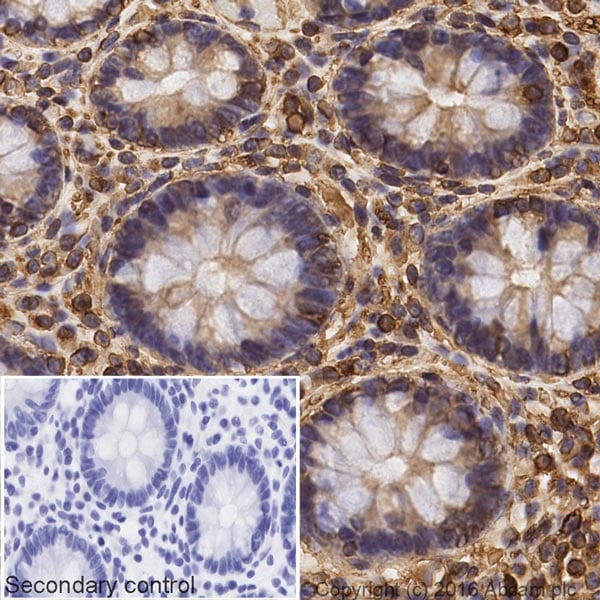Donkey Anti-Mouse IgG H&L (Biotin) (ab208001)
Key features and details
- Donkey Anti-Mouse IgG H&L (Biotin)
- Conjugation: Biotin
- Host species: Donkey
- Isotype: IgG
- Suitable for: Flow Cyt, IP, ICC/IF, WB, IHC-Fr, IHC-P, ELISA
Overview
-
Product name
Donkey Anti-Mouse IgG H&L (Biotin)
See all IgG secondary antibodies -
Host species
Donkey -
Target species
Mouse -
Specificity
This antibody is specific to Mouse IgG -
Tested applications
Suitable for: Flow Cyt, IP, ICC/IF, WB, IHC-Fr, IHC-P, ELISAmore details -
Immunogen
The details of the immunogen for this antibody are not available.
-
Conjugation
Biotin
Properties
-
Form
Liquid -
Storage instructions
Shipped at 4°C. Store at +4°C short term (1-2 weeks). Upon delivery aliquot. Store at -20°C. Avoid freeze / thaw cycle. Store In the Dark. -
Storage buffer
pH: 7.40
Preservative: 0.02% Sodium azide
Constituents: PBS, 1% BSA, 30% Glycerol (glycerin, glycerine) -
 Concentration information loading...
Concentration information loading... -
Purity
Affinity purified -
Purification notes
Immunogen affinity purified - This antibody was isolated by affinity chromatography using antigen coupled to agarose beads and conjugated to Biotin. -
Clonality
Polyclonal -
Isotype
IgG -
Research areas
Images
-
 Immunohistochemistry (Formalin/PFA-fixed paraffin-embedded sections) - Donkey Anti-Mouse IgG H&L (Biotin) (ab208001)
Immunohistochemistry (Formalin/PFA-fixed paraffin-embedded sections) - Donkey Anti-Mouse IgG H&L (Biotin) (ab208001)IHC image of Histone H4 staining in a section of formalin-fixed paraffin-embedded normal human colon tissue*. Ab208001 Donkey Anti-Mouse IgG H & L (Biotin) was used as the secondary antibody.
Staining was performed on a Leica BondTM. The section was pre-treated using heat mediated antigen retrieval with sodium citrate buffer (pH6, epitope retrieval solution 1) for 20 mins, before blocking of endogenous biotin using ab64212. The section was then incubated with ab31830, 1/100 dilution, for 15 mins at room temperature, followed by ab208001, 1/500 dilution, for 15 mins at room temperature. Detection was via an HRP conjugated ABC system and DAB was used as the chromogen. The section was then counterstained with haematoxylin and mounted with DPX.
The inset negative control image is taken from an identical assay without primary antibody.
For other IHC staining systems (automated and non-automated) customers should optimize variable parameters such as antigen retrieval conditions, primary antibody concentration and antibody incubation times.
*Tissue obtained from the Human Research Tissue Bank, supported by the NIHR Cambridge Biomedical Research Centre
-
ab208001was tested by direct ELISA, where wells were coated with serially diluted mouse IgG (1000 – 16 ng/ml) for 2 hours, followed by a 2 hour blocking step (5% BSA). ab208001 (1:20,000 dilution; 2 hours) was added and detected by streptavidin-HRP (ab7403; 1:10,000 dilution; 1 hour). Signal was developed by TMB substrate. Data from duplicates; +/- SD.
-
 Immunohistochemistry (Formalin/PFA-fixed paraffin-embedded sections) - Donkey Anti-Mouse IgG H&L (Biotin) (ab208001)
Immunohistochemistry (Formalin/PFA-fixed paraffin-embedded sections) - Donkey Anti-Mouse IgG H&L (Biotin) (ab208001)IHC image of alpha Tubulin staining in a section of formalin-fixed paraffin-embedded normal human colon tissue*. Ab208001 Donkey Anti-Mouse IgG H & L (Biotin) was used as the secondary antibody.
Staining was performed on a Leica BondTM. The section was pre-treated using heat mediated antigen retrieval with sodium citrate buffer (pH6, epitope retrieval solution 1) for 20 mins, before blocking of endogenous biotin using ab64212. The section was then incubated with ab7291, 1/100 dilution, for 15 mins at room temperature, followed by ab208001, 1/500 dilution, for 15 mins at room temperature. Detection was via an HRP conjugated ABC system and DAB was used as the chromogen. The section was then counterstained with haematoxylin and mounted with DPX.
The inset negative control image is taken from an identical assay without primary antibody.
For other IHC staining systems (automated and non-automated) customers should optimize variable parameters such as antigen retrieval conditions, primary antibody concentration and antibody incubation times.
*Tissue obtained from the Human Research Tissue Bank, supported by the NIHR Cambridge Biomedical Research Centre









